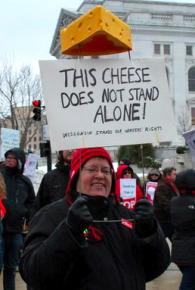A breath of fresh Wisconsin air
tells what he's learned from the Packer-loving protesters in Wisconsin.
THE OTHER week, Jon Stewart called the Madison protests "the Bizarro Tea Party." It seems that there's been so little old-fashioned working-class rebellion in recent years that even the super-sharp folks at the Daily Show have trouble recognizing it: This is odd. Students and workers are gathering in large numbers to hold signs and march and chant. But they're saying nothing about anchor babies or false birth certificates. What do you call this strange phenomenon?
Of course, it's the Tea Party that is a funhouse reflection of genuine grassroots protest movements--billionaires organizing mad-as-hell rallies against the working class. Getting it reversed is like telling a Kansas City barbeque chef that his food tastes like a Bizarro McRib sandwich.
Conservative commentators, meanwhile, saw the tens of thousands of smiling students and teachers as a sinister gang of "union thugs." That's actually the term Rush Limbaugh and others have used to describe members of the Wisconsin Education Association. Ooh, don't cross Mrs. Mendelson at Oshkosh Elementary. Your body might end up at the bottom of a sandbox.

Actually, the quality that jumps out at anyone who watches any video from Madison is the humor--something I've never seen at any Tea Party Paranoia-palooza.
I've never seen as many hilarious protest sign, ranging from the nerdy ("There's Still Good in You (Sky)Walker") to the admirably straightforward ("Dick Move, Scotty").
Wisconsinites taught me two things with their handmade signs. They identify with the Egyptian struggle for democracy. And they really love the Green Bay Packers. I wouldn't be surprised if some wall in the Capitol building now features a Diego Rivera-style mural featuring Vince Lombardi and company marching in Tahrir Square.
There were also plenty of signs reflecting the gallows humor of public-sector workers: "My Kindergarteners Are Better Listeners than My Governor." "Hey Walker WI Ranger. Who's Gonna Wipe Your Ass When You Have a Stroke?" "I Protect Your Family From the Criminally Insane. Remember That."
Signs like these helped build national support by showing that the protesters are the regular people we all work with. And yet at a typical union rally anywhere else, folks stand around holding pre-printed signs and listen to speakers with a pre-printed message: "Vote for the Democrats in November." Doesn't it seem like a poor use of resources to mobilize thousands of working to assemble in one location just to give them a live version of the e-mails you regularly send them?
In Wisconsin, the unions had to break this mold because Scott Walker attacked them so hard and so quickly. The same old symbolic protest wouldn't do; workers and students in Madison had to figure out what they were going to do to try to actually kill the bill. That's how "See you in November" became "We'll see your ass every day until we win." That's how "I'm a union member and I vote" became "I'm a teacher and I call in sick."
Walker's attack forced the Wisconsin labor movement to rediscover a long-forgotten lesson: Protests can, like, try to win. Workers can strike--or at least call out sick for three days like the teachers did. State senators who oppose bad legislation can leave the state. And the rest of us can stay.
THE OCCUPATION of the state Capitol building has mercifully ended a debate that's raged in activist circles for over a decade: Is it better to have a tame protest with many people or a disruptive protest with few people? Now it's clear that this has essentially been an argument about the relative merits of peanut butter versus jelly. How about both?
Turns out that mass occupations of public spaces have lots of other advantages too. Having a hard time to decide what time to call the rally? Make it all the time! Are you worried that some folks are going to be out of town? They can join us when they get back. Tell them to bring postcards to put up in the rotunda.
Another logistical task that the Madison protesters have simplified is the follow-up meeting, which is now defined as when you get tired of chanting and sit down over some internationally donated pizza. When should you have the next rally? When there's no more pizza.
But occupations and daily protests can't last forever because most people have to go back to work. That's one of Scott Walker's big advantages--he and the Koch Brothers get to plot against us while they're at work because that's their job.
Now that most of the protesters have gone back home and the union officials are back in charge, the main slogan seems to be, "It's not about the money." This slogan hopes to portray union workers as reasonable folk who will pay more for their benefits, but just want to keep their bargaining rights.
Actually, it tells Scott Walker to stand firm because the unions are already starting to cave. And it may tell other workers that the unions will fight for their own "special" rights, but not against the cuts to everybody's health care and education.
At the Capitol building protests, workers were doing a fine job of portraying themselves in ways that no political consultant would have approved. Let me great this straight. You want to compare yourselves to Egyptian protesters-- to angry Arab young men? You're worse than the one with the sign about wiping Scott Walker's ass!
So the big question is if Wisconsin workers and students are going to be able to take the spirit of mass participation back to their hometowns, campuses and union meetings. Hopefully over the next couple of weeks, we'll be hearing not only from the people who make the pre-printed signs, but from the ordinary Mubarak-hating, Packer-loving, ass-wiping workers of Wisconsin.


